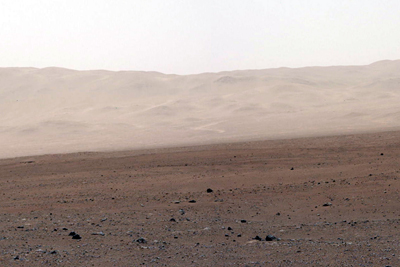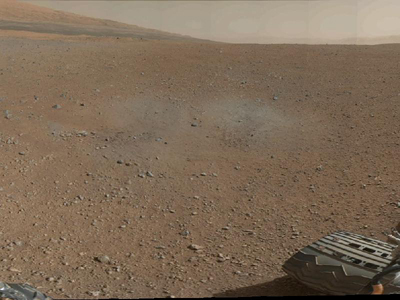Cornell astronomers roving Mars with Curiosity
By Linda B. Glaser


In a daring feat of technological nerve and skill, NASA landed a 1-ton rover on the surface of Mars Aug. 6. The rolling laboratory is designed to help answer the question humans most want to know about Mars: Is there now or has there ever been life on the Red Planet?
The rover, named Curiosity, holds equipment designed to look at environments where life might have existed and to assess whether those environments preserve evidence of past life. But none of it would have happened if even one thing had gone wrong with the landing sequence, which according to NASA required six vehicle configurations, 76 pyrotechnic devices, the largest supersonic parachute ever built and more than 500,000 lines of code.
The "seven minutes of terror" before Curiosity landed safely on Mars was particularly nail-biting for the Cornell astronomers who are members of Curiosity's science team.
"The landing site looks as interesting as was predicted, so Curiosity is now ready for an incredibly rich exploration of Mars' history," said Peter Thomas, who -- along with Rob Sullivan, both senior research associates at Cornell's Center for Radiophysics and Space Research -- works on the Mars Science Laboratory's camera science team with three instruments: mast cameras ("Mastcam"), a descent imager and a hand lens imager for close-up pictures.
The Mastcam consists of two digital color cameras mounted high on Curiosity's mast. The right Mastcam has a telephoto lens with a three-fold better resolution than any previous landscape-viewing camera on the surface of Mars. According to NASA, its resolution is good enough to distinguish a basketball from a football at a distance of seven football fields, or to read the words "one cent" on a penny on the ground next to the rover. Best of all, combining information from the left and right Mastcams will yield 3-D views of the telephoto part of the scene.
Alex Hayes, joining Cornell's faculty in January and currently an adjunct professor of astronomy, is also a collaborator on the Curiosity mission, working with several members of the various camera teams.
Goldwin Smith Professor of Astronomy Steve Squyres is now roving Mars with two different missions. He continues as principal investigator for the ongoing Mars Exploration Rover mission and is also working with Curiosity's MSL APXS and SAM (Sample Analysis at Mars) instruments, which are designed to measure the composition of Mars' surface.
The APXS, an alpha-particle X-ray spectrometer, will use radiation to determine the elemental composition of samples. SAM is a suite of instruments that can analyze organics and gases from both atmospheric and solid samples.
Students who want to get close to the Curiosity mission this fall should consider taking Squyres' "History of Exploration: Land, Sea and Space," course, co-taught with Mary Beth Norton, the Mary Donlon Alger Professor of American History. At the beginning of each session, Squyres will give an update on both rover missions. He'll have to Skype into the first session Aug. 22 though, as he'll be at the Jet Propulsion Laboratory and still living on Mars time.
Linda B. Glaser is staff writer for the College of Arts and Sciences.
Media Contact
Get Cornell news delivered right to your inbox.
Subscribe